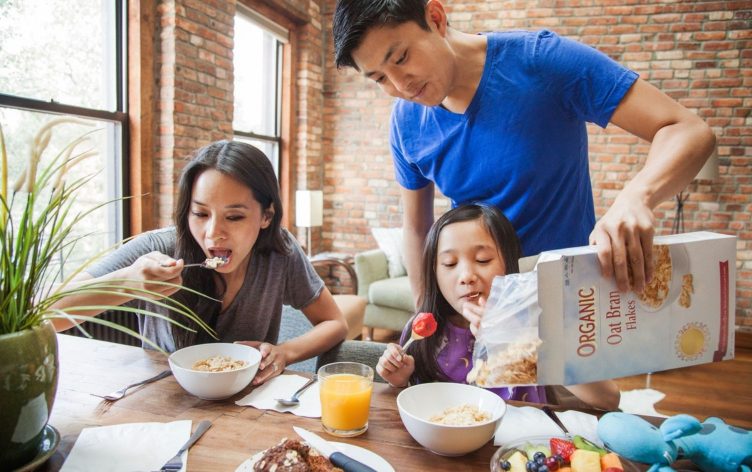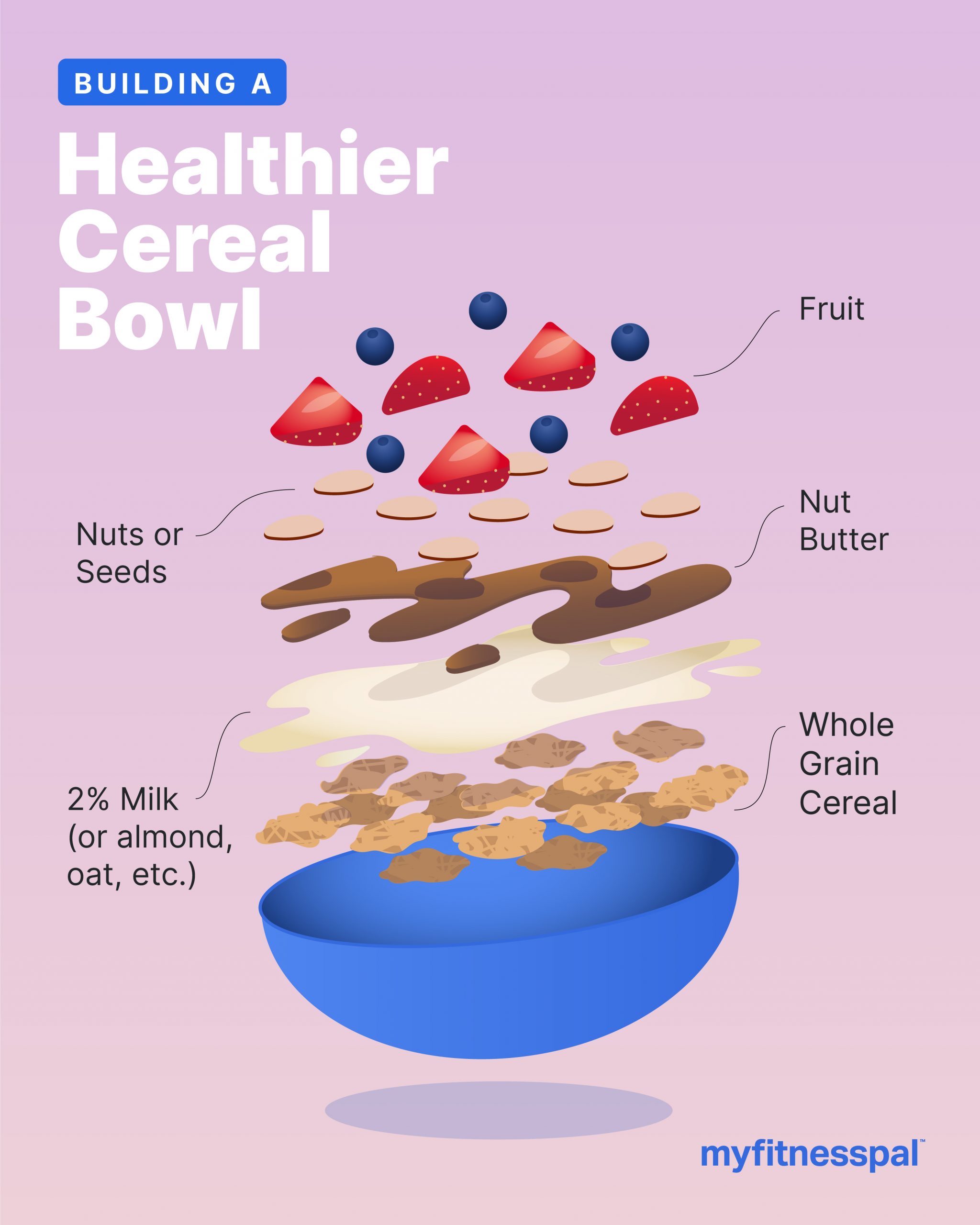
Build a Better Cereal Bowl
As a kid, your go-to breakfast may have been a bowl of cold cereal. For adults, it almost feels like a guilty pleasure. “I feel like cereal got a bad rap when everyone started focusing on low-carbohydrate diets,” says Melissa Rifkin, RD, CDN, a New York dietitian. And yes, cereal does have more carbs compared to other breakfast foods — but it also offers a lot of other good nutrients, too.
Fortunately, though, over the years, brands have developed better-for-you cereals, says Rifkin. They’ve done this by lowering the sugar content, pumping cereal up with whole grains, and adding protein.
Beyond buying the right cereal (we’ll call it your base), you should also consider the milk you add (both cow’s milk and plant-based milk), and potential toppings to add nutrients, additional protein, and healthy fats to ensure the meal holds you over until lunch.
Here’s your dietitian-approved, step-by-step guide for building a better cereal bowl:

THE BASE
The first step toward a good breakfast starts at the store. Look for a cereal that contains less than 8 grams of sugar and at least 8 grams of protein per serving, suggests Melissa Mitri, a registered dietitian nutritionist and owner of Melissa Mitri Nutrition in Milford, Connecticut. “Many cereals may be promoted as healthy, but pack a lot of added sugar,” she explains. That added sugar can lead to a spike in blood sugar; when your blood sugar subsequently comes crashing down, you’ll feel it in the form of fatigue and sugar cravings. “Choosing a cereal that also has enough protein will help keep you fuller so you don’t have that mid-morning crash,” Mitri adds. Fiber can also help you feel satiated, and Rifkin recommends looking for cereals with at least 3 grams of fiber per serving.
Along with looking at the nutrient facts panel, you should analyze the ingredients. Search for whole grains or whole-grain oats as one of the first ingredients. If whole grains appear near the end of the list, consider another option. Also, consider the length of the ingredient list. “When I see a very long ingredient list, I know that cereal is highly processed, which can mess with your metabolism and hunger signals,” Mitri says.
Bummed that you can’t eat your favorite cereal because it’s too sugary? You don’t have to give it up completely. A cool trick is to mix a lower-sugar and a higher-sugar whole-grain cereal, says Mitri. You can do a 50/50 mix or fill most of the bowl with the lower-sugar cereal and top it with just a bit of the sugary one, so you get the taste first.
THE LIQUID
You have several options, and the milk you choose mostly depends on your taste and dietary preferences.
First up: cow’s milk. If you go for this option, Rifkin recommends choosing 2% milk. “I notice that a higher fat milk is more satiating,” she says, adding that the fat also helps your body absorb some of the vitamins in the meal.
If you like the creamy taste of cow’s milk but your stomach is sensitive to lactose (a naturally occurring milk sugar), Mitri recommends Fairlife Lactose-Free Ultra-Filtered Milk. “It contains 50% more protein and 50% less sugar than regular dairy milk. “Many people have trouble getting their protein at breakfast, and choosing a higher protein milk can help you meet your needs,” she says.
Don’t do dairy? No problem. You also have a lot of options when it comes to plant-based varieties: almond, coconut, oat, hemp, cashew and soy, among others. Choose unsweetened versions to keep sugar in check. Overall, these tend to have lower amounts of protein. For instance, 1 cup of cow’s milk contains 8 grams of protein, while 1 cup of almond milk contains 1 gram of protein, per the USDA. (The exception is soy milk, which has a similar protein content to cow’s milk.) One option for pumping up the protein content is to stir in a protein powder, suggests Rifkin, who likes to add a vanilla protein powder with 20 grams of protein per scoop.
CLICK TO TWEET THIS ARTICLE > Can cereal ever be healthy? Experts discuss via @myfitnesspal. #MyFitnessPal
THE FINISH
Now, this is where things can get fun — and tasty. You can add nutrition to your bowl with toppings that supply extra protein, healthy fats, fiber and antioxidants. Some ideas to get you started:
Fruit: Bananas might be classic, but also opt for berries (raspberries are low in carbs and high in fiber), apricots, figs, peaches, pears or apples. A small amount of dried fruit, such as dried apricots or strawberries, also adds a punch.
Nuts and seeds: Many kinds of cereal include nuts, such as sliced almonds, peanuts, pecans, and walnuts, or seeds, such as sunflower or pumpkin. But if yours doesn’t, sprinkle these on top. “These toppings boost the fiber content, add healthy anti-inflammatory fats, as well as additional protein to hold you over all morning,” says Mitri. Certain seeds — chia, flax, hemp — are also packed with heart-healthy omega-3 fatty acids, adds Rifkin.
Nut butter: A small scoop of your go-to nut butter can add a unique creaminess to your bowl. Just like nuts, nut butter provides healthy fats and extra protein. Just make sure to use one made without added sugar, and watch the serving size, since 1 tablespoon supplies about 100 calories.
Chocolate or coconut: Yes, you’re reading that right. Rifkin sometimes throws a few chocolate candies on top. (She likes the Unreal brand, but you can also do this with dark chocolate chips.) Another idea? A sprinkling of unsweetened coconut shreds or a few lightly sweetened coconut chips on top.
THE BOTTOM LINE
Cereal can be a healthy option for a meal or a snack. “Be creative with your cereal bowls and have fun adding healthy toppings to make it a complete meal,” says Mitri.





